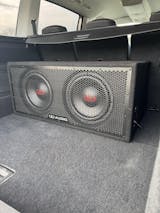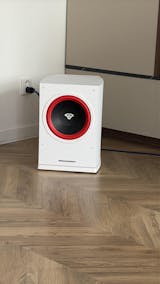The role of amplifier classes: How to optimize your car hi-fi audio system

The different amplifier classes and their properties
Classification of the amplifier classes: A, B, AB and D
Amplifiers are among the most important components in the world of car hi-fi, as they have a decisive influence on the sound of the audio system. There are four different amplifier classes, each of which has its own advantages and disadvantages. These are amplifier classes A, B, AB and D, which are classified according to how the power amplifier works. Class A generally operates with high distortion and low efficiency, while class B and AB, as well as class D, generally operate more efficiently and therefore consume less power.
Sound quality and efficiency in the different classes
Each amplifier class has its own characteristics when it comes to sound quality and efficiency. Class A is known for offering excellent sound quality, but consumes a lot of power due to its low efficiency. Class B works more efficiently than class A, but the sound quality is slightly poorer. Class AB is often the best choice when it comes to finding a good balance between efficiency and sound quality. Class D is the most efficient amplifier class, but the sound quality is often poorer than the other classes.
Typical applications and areas of use of the classes
The different amplifier classes are suitable for different applications and areas of use. Class A is often used in audiophile systems that place the highest value on sound quality. Class B is ideal for use in less expensive audio systems that do not place high demands on sound quality. Class AB is the best choice in many cases, as it combines good sound quality with good efficiency. Class D is often used in car speaker systems and is ideal for applications where high efficiency is required, such as in vehicles.
Overall, there are many differences between amplifier classes and it is important to choose the right class to optimize the car sound system. By using the best class of amplifier for the requirements of the audio system, improvements can be made to the sound quality in the car speaker system. A comparison of amplifier classes is therefore essential in order to make the best choice for the application in question.
Advantages and disadvantages of the amplifier classes in the car hi-fi sector
Amplifier class A
Amplifier class A is known for its high sound quality, as all transistors are constantly active. However, it also has low efficiency, which means that power consumption is high and the amplifier often gets hot during operation. This class is best suited for demanding music lovers who are willing to pay for the best sound quality and do not want to compromise on performance.
Amplifier class B
Amplifier class B has a higher efficiency than class A, but the sound may be affected because the transistors are not constantly active. This can lead to distortion, especially at low volumes. However, this is not normally audible and most people prefer the higher efficiency to the minimal loss in sound quality.
Amplifier class AB
Amplifier class AB is a combination of class A and B and offers the best sound quality and efficiency compared to the other amplifier classes. It is very versatile, both for high-quality home and car audio systems and is suitable for demanding music lovers who want good sound quality and high efficiency.
Amplifier class D
Amplifier class D has the highest efficiency as it uses Pulse Width Modulation (PWM) technology. This makes it particularly useful for use in car speakers, as it does not put too much strain on the vehicle's battery. However, the sound quality is lower than the other amplifier classes and distortion can occur. This class is a good choice for users who want to conserve their vehicle's battery while achieving adequate sound.
Overall, it is important to understand the differences between the various amplifier classes in order to make the best choice for your individual car hi-fi audio system. By selecting an amplifier class that meets the requirements of the system and harmonizes with the speakers, you can improve your car sound system and increase the sound quality. An amplifier class comparison for car speakers should definitely be carried out to ensure that you choose the best amplifier class for your car system.
Which amplifier class is the best for the car hi-fi audio system?
The speaker types
First of all, the speaker types of the audio amplifier for the vehicle should be considered. The type of speakers should harmonize with the amplifier class. For example, a class A amplifier is ideal for speakers with low sensitivity and high current and power requirements.
The sound quality
The choice of the right amplifier class should also be based on the sound quality you want to achieve. Each amplifier has different characteristics and can affect the sound quality. If you want very high sound quality, you should consider a class A or AB amplifier class, while for higher efficiency and less power consumption you could choose class D.
Power supply
The power supply is another important factor when choosing the amplifier class. Some types of audio amplifiers draw more current than others, which can drain the vehicle's battery very quickly. For this reason, you should select an amplifier class that takes into account the power requirements of the car audio system.
The costs
The cost of the amplifier class should also be taken into account. Each amplifier class has its own price, which depends on the performance and quality. It is important to be aware that higher performance and quality can also mean higher costs.
The amplifier class comparison
After considering all factors, an amplifier class comparison for car speakers should be carried out. The comparison will help you choose the best amplifier class for your car sound system. There is no definitive answer as to which amplifier class is best as it depends on individual preferences and requirements. However, by comparing the amplifier classes and their differences, you can make an informed decision and get the best out of your car hi-fi audio system.
Integration and installation of the optimum amplifier in the car hi-fi system
Ensuring correct cabling and integration into the system
Correct cabling when installing the audio amplifier for the vehicle is extremely important in order to achieve the best results when optimizing the car sound system. It should be noted that high-quality and shielded cables should be used for good signal transmission. The positioning of the amplifier is also crucial for the sound quality in the car. The cables should be kept as short as possible to avoid interference.
Optimization of the settings and adjustments to the amplifier
After correct wiring, it is important to configure and adjust the audio amplifier in the vehicle correctly to get the best out of the car audio amplifier. This includes, for example, setting the crossover to avoid speaker overlap. The tone control should also be adjusted accordingly to ensure optimum sound. The manufacturers of the audio amplifiers for the vehicle usually also provide recommendations for adjustment and, in the case of more difficult installations, it is also worth seeking expert advice.
Professional installation and assembly of the amplifier in the vehicle
Installing the amplifier is the final stage in optimizing the car sound system. Care should be taken to ensure that the amplifier is securely and firmly attached to the designated place in the vehicle. In the worst-case scenario, an unsecured bracket can cause the wiring to come loose, resulting in a short circuit or fire in the car. Installation instructions as well as all necessary cable connections and fastening materials are usually supplied with the amplifier and should always be carefully observed. A professional and correct installation of the audio amplifier for the vehicle can achieve a high-quality and gapless performance.
By following these essential steps when integrating and installing the amplifier in the car hi-fi system, the sound quality of the car speaker can be improved and the best amplifier class car sound can be selected. An amplifier class comparison of car speakers can therefore be very helpful. The optimized car hi-fi audio system thus becomes an auditory experience that not only delights the driver but also the passengers.
Amplifier classes for car hi-fi audio systems
In this article, we have discussed the importance of amplifier classes for the optimization of car hi-fi audio systems. The different amplifier classes, such as class A, B, AB and D, are crucial for the sound quality, efficiency and performance of the car sound system. Class A offers excellent sound quality but at the expense of efficiency, while Class B and AB offer a good compromise between sound quality and efficiency. Class D is characterized by its high efficiency, but is less convincing in terms of sound quality.
It is important to choose the right amplifier class for your car hi-fi system by considering speaker types, sound quality, power supply, cost and a comparison of amplifier classes. By choosing the optimal amplifier class, the sound quality of the car speaker can be improved and the best amplifier class car sound can be selected.
In addition, it is important to integrate the amplifier into the car hi-fi system professionally, paying attention to correct wiring, settings and mounting. The use of high-quality cables, the correct positioning of the amplifier, adjustments to the tone control and crossover as well as a secure mounting of the amplifier in the vehicle are crucial to get the best out of the selected amplifier class.
In summary, choosing the right amplifier class and integrating and installing it properly into the car hi-fi system is crucial to optimize the sound quality and music experience while driving. An amplifier class comparison will help you make the best decision for your car sound system and ultimately lead to an audiovisual experience that will impress drivers and passengers alike.







